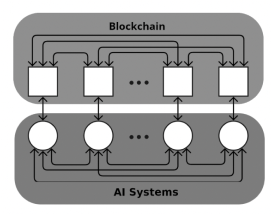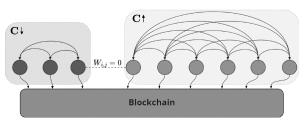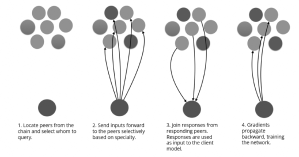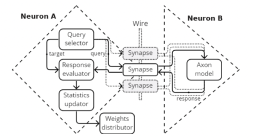Incentivizing Intelligence: The Bittensor Approach
Jacob Steeves / Ala Shaabana / Yuqian Hu / Francois Luus / Sin Tai Liu / Jacqueline Dawn Tasker-Steeves / Opentensor Foundation
00/ Abstract
Inspired by the efficiency of financial markets, we propose that a market system can be used to effectively produce machine intelligence. This paper introduces a mechanism in which machine intelligence is valued by other intelligence systems peer-to-peer across the internet. Peers rank each other by training neural networks that are able to learn the value of their neighbours, while scores accumulate on a digital ledger. High-ranking peers are rewarded with additional weight in the network. In addition, the network features an incentive mechanism designed to resist collusion. The result is a collectively run machine intelligence market that continually produces newly trained models and rewards participants who contribute information-theoretic value to the system.
01/ Introduction
The production of machine intelligence relies almost exclusively on a system of benchmarking, in which a model’s performance is assessed on narrowly defined supervised problems. While this method works well for task-specific problems, measuring machine intelligence solely with supervised objectives causes the field to converge towards narrow specialists, as opposed to resilient generalists (Radford et al. [2019]).
In 2012, an inflection point occurred when AlexNet achieved state-of-the-art performance on the ImageNet competition (Krizhevsky et al. [2017]). This triggered a sharp acceleration in the development of new neural network approaches able to overcome purely statistical methods with high dimensional, representation-based approaches. Only a few years later, Vaswani et al. introduced the first-ever unsupervised learning method that would surpass supervised learning regimes in language understanding (Vaswani et al. [2017]). These innovations demonstrate that researchers can achieve state of the art results by making consistent, incremental improvements upon previous work, consistently adding to a shared base of research over time.
However, since intelligence produced by these models is always lost, this approach is quite inefficient. Users have to retrain models on their own systems to replicate, or improve upon, the work of others. Consequently, this leads to unnecessary computational loss in learning tasks that other models have already learned.
Additionally, there is the issue of model evaluation. Presently, new research must go through the academic peer review process to investigate the work while ensuring quality and correctness. While this process has its benefits, it creates a system that is unscalable and subject to human bias. It is notoriously difficult to reproduce artificial intelligence research Gundersen and Kjensmo [2018]. There must be a more efficient and objective method to evaluate AI model performance.
In this paper, we introduce the Bittensor Network: a decentralized peer-to-peer machine learning protocol. In the network, machine intelligence is measured by other intelligence systems in a continuous and asynchronous peer-to-peer (P2P) fashion across the internet. Models are ranked for informational production regardless of the subjective task or dataset used to train them. By changing the basis against which machine intelligence is measured, the market can reward intelligence that is applicable to a much larger set of objectives while still preserving the unique value of legacy systems and smaller diverse systems that find niches within the reward landscape. The constructed market uses a digital ledger to record ranks and to provide incentives to the researchers, thus allowing them to directly monetize their machine intelligence work. It is divided into two layers: the AI layer and the Blockchain layer (Figure 1).

Figure 1 / schematic of the bittensor network.
02 Blockchain layer
The Blockchain layer is a layer-0 blockchain based on Polkadot Substrate (Wood [2016]), and is responsible for enforcing the consensus mechanism, ensuring peer identity, and incentivizing network peers. The blockchain layer resides directly underneath the AI layer, and communication between the two layers is achieved through inter-process communication. In order to fairly distribute incentive across all of the participating peers, the Bittensor network leverages a staked weighted trust through consensus. Peers are incentivized to rank each other, and highly ranked peers will receive additional rewards. The blockchain does not trust rankings from any individual peer on the network, but rather trusts the collective rankings from all of the participating peers. In order to submit their rankings, peers must first register their wallets, and a pair of cryptographic keys that are unique to each peer. The same keys will be required to sign all transactions to the chain and all communication requests between peers. These cryptographic keys will serve as the main identification tool for peers on the network.
Additionally, the blockchain maintains the system’s incentive mechanism, designed primarily for peer-rankings systems and to solve for the problem of collusion, which occurs when a small fraction of the network works selfishly together as a means to maximize their rewards.
To solve this problem, we have leveraged a trust based incentive mechanism by rewarding peers in the network who are “trusted” and have reached consensus. The incentive mechanism utilizes a stake vector S and a set of weights W where rows are inter-peer rankings. We also infer a trust matrix T from the weights, where ti,j = 1 if and only if there is a non-zero edge between peer i and j.

We define peers who have reached “consensus” as those with a positive weight settings from more than 50 percent of stake (T > 0.5) in the network. Hence, when more than 50% of the incentive goes to consensus peers, then the chain can be considered as having reached consensus. This is regularized on the chain by the sigmoid function defined by Equation 2 such that peers who have reached consensus receive significantly higher rewards. Effectively, the threshold-like sigmoid rewards connected peers and punishes the untrustworthy peers.

We use the consensus term to scale the original rankings. This ensures the majority of the incentive is distributed to peers that trusted by a majority of the network.

To give an example of how this might work in practice, consider a scenario in which a colluding cabal C has formed on the network Figure 4. The cabal will actively try to maximize their inflation by only ranking themselves highly while providing no informational knowledge for the honest H peers on the network. In this disconnected network, the two subgroups will only vote for peers in its own group with little to no weights for peers of the opposite group (Figure 4). Assuming that the chain has reached consensus, the fight between honest H peers and cabal C peers can be determined by the portion of initial stake each sub-group contains.

Figure 2 / Disjointed sub-networks: Cabal peers (left) only vote within its own group and does not interact with a majority of the peers and stake on the network. This results a lower consensus C score for the sub-network and thus a lower incentive.
In the event that the stake in the honest sub-graph is greater than the cabal (SH > SC ), only peers within the honest subgroup are capable of reaching consensus and will receive the majority of the incentive from the chain. The disagreement between the majority stake holders SH, and the dishonest sub-graph results in a penalized consensus and therefore incentive for the C sub-graph. As such, the ratio of stake SC SC +SH decreases over time, and the cabal must continually add stake to maintain its position. These cabal attacks are akin to the 51% attacks present in other blockchains (Sayeed and Marco-Gisbert [2019]). However, our stake based ranking system – like other proof of stake systems – present significantly higher risks for the attackers that endanger the value of their own tokens.
Additionally, our incentive mechanism includes a bonding mechanism (Appendix Section 9) to provide additional incentives for peers who validate honestly. Similar to market-based speculation in traditional equities, the peers that have accumulated bonds in peers that others will later value attain increased inflation themselves.
03 AI layer
In addition to inference and training, the AI layer is responsible for abstracting away the Bittensor kernel and ensuring input/output compatibility of a node’s neural network with the rest of the network’s peers. Each node on the Bittensor Protocol contains a single neural network. From now on, we will be referring to these nodes as neurons; this is not to be confused with individual neurons in traditional neural networks.
The Bittensor Protocol is composed of n parameterized functions (or neurons) F = f0, ..., fj , ...fn distributed in a peer-to-peer fashion. Each neuron is holding zero or more network weights S = [si ] (or “stake”) represented on a digital ledger. Our goal is the distribution of stake I – as incentive – to peers who have contributed the most informational value.
Figure 2 shows a high level overview of the forward and backward passes performed on the Bittensor network and describes the process by which neurons train on the Bittensor protocol. Similarly to the Hivemind proposal by Ryabinin et al., peers are able to request others for forward passes and subsequently propagate backward gradients over the wire. By querying for information, Bittensor offers inference across all of the nodes serving on the network. Unique to Bittensor, this enables an distributed trust-less style of machine learning where requests are authenticated and verified using the digital ledger. The Blockchain layer ensures the identity of each peer through a unique cryptographic key and maintains the integrity of incentive distribution and rankings over the entire network.
In Bittensor, peers who are highly ranked receive the most incentive. Peers use the outputs of others F(x) = [f0(x)...fn(x)] as inputs to themselves f(F(x)) and learn a set of weights W = [wi,j ] where peer i is responsible for setting the i th row through transactions on a digital ledger. We describe peer ranking in more detail in Section 4.
Figure 3 shows a cutaway diagram of two neurons on the Bittensor network. Synapses function as the main transmitter between neurons and ensure all of the transmission tensors are formatted in correspondence to the Bittensor protocol. Each synapse dictates a different ML task, and therefore follows a different compression and communication process. This ensures that all logits and embeddings being transported over the Bittensor protocol are sanitized, correct, and contribute useful information. If a neuron is acting maliciously or sending incorrect tensors across the wire, Synapses ensure that their rankings and rewards are penalized as a result. Currently, the Bittensor network is focused on large language modelling and contains 4 separate synapses for text-related tasks ( LastHiddenState, CausalLM, CausalLMNext, and Seq2Seq). Prior works have shown that large language models can be continually fine-tuned for improved performance for downstream tasks (Scialom et al. [2022],Ouyang et al. [2022]). The Bittensor protocol achieves the same continual fine-tuning process while being fully distributed and trust-less over the web.

Figure 3 / Neurons training on the Bittensor Protocol. The Bittensor protocol utilizes a mixture-ofexperts (MoE) architecture with each remote peer acting as a single expert(Shazeer et al. [2017]; Ryabinin and Gusev [2020]).

Figure 4 / Neurons training on the Bittensor Protocol. The Bittensor protocol utilizes a mixture-ofexperts (MoE) architecture with each remote peer acting as a single expert(Shazeer et al. [2017]; Ryabinin and Gusev [2020]).
04 game-theoretic scoring
A crucial element of the Bittensor Protocol is the production of an accurate ranking method. Peers are ranked based on their informational significance to the overall collective, represented by a ranking r = [ri ] where score ri ∈ R represents a participant’s contribution to the benchmark. This is done by calculating its Shapley value ϕ (Shapley [1952]) which is a way to fairly distribute the contribution for each participant in a group by permuting through all possible combinations of the subsets:

where N and S represent the complete set and a single set of peers respectively. CE(S) is the cross-entropy loss give S set of peers, ϕi represents the Shapley value for a peer i.

Figure 5 / Shapley score comparison between large language models (LLM) of various sizes (GPT 2 — 117M, GPT-neo — 125M, GPT-J — 6B, GPT-neox — 30B) (Wang and Komatsuzaki [2021] , Black et al. [2022]) by a single validator. The scoring was done on the Bittensor network, and models were scored based on their performance at last token prediction. Larger models capable of achieving lower loss are given a higher Shapley score by their peer.
In order to calculate the Shapley score for thousands of peers, the network leverages a sparse Monte Carlo estimation method. In terms of the AI layer, this is akin to a sparsely gated mixture-of-experts (MoE) layer (Shazeer et al. [2017], Fedus et al. [2021]) such that only a portion of the network is queried at a given time. This was implemented to allow the network to scale efficiently without facing any computational bottlenecks.

where gj (x) represents the output of the gating network and fj (x) represents the response from peer, j. Unlike previous MoE models where routing determines the parameters to activate, our gating layer determines the optimal peers in the network to query for each example. Responses are then used as the inputs as part of a local model and evaluated for their contribution. This cuts outward bandwidth 5 by querying only a small subset of peers for each example and thus also reducing the number of possible permutations in our Shapley calculation.
The sparse combinations of peers effectively represent a subset of the possible permutations within the complete set of N peers. Given enough samples, we can recover the full Shapley values and a cooperative ranking r for the entire network. Benchmarks of several LLMs currently running on the Bittensor network are showcased in Figure 5.
05 the current state of the bittensor network
The Bittensor network officially launched in November 2021. As of writing this paper, the network contains 4096 peers; all of which are running a language model that is actively querying others for information or serving requests from other peers on the network. With a total sum of 500 Billion parameters running across 4096 peers, it is possible to query and infer from every node in the network and receive an output of logits, embeddings, or plain text responses given a prompt. Each peer is either running a custom language model, or a pre-trained model such as GPT-J (Wang and Komatsuzaki [2021]), GPT-Neo, (Black et al. [2021]), or GPT-2 (Radford et al. [2019]) downloaded from HuggingFace API (Wolf et al. [2020]).
In 2022, the protocol underwent several algorithmic, consensus, and infrastructure changes to ensure correctness and scalability. The Bittensor team is now training more sophisticated models directly on the Bittensor protocol to work towards achieving performance comparable to current state of the art models.
06 Conclusion
We have introduced the first peer-to-peer, trust-less intelligence market that features a novel ranking benchmark. The benchmark measures performance as representational-knowledge production using other intelligence systems to determine its value. Due to its high-resolution, highly collaborative nature, this benchmark has the potential to be the gold standard in machine learning testing and evaluation.
The paper began with the definition of the Bittensor Protocol, a P2P network composed of abstractly defined intelligence models. Peers are able to directly query each other for informational embeddings that serve as inputs to their own models. Training can occur by subsequently propagating backward gradients to responsive peers. We then showed how this framework allows us to produce a cooperative game-theoretic ranking for each peer based on its informational value for the network. These scores are passed on to a digital ledger where a trust-based incentivization is distributed. Peers that earn high scores from a majority of stake holders will receive the majority of the incentive. We then demonstrated how this incentive scheme based on peer connectivity prevents participants from forming dishonest sub-graphs such that over time, dishonest sub-graphs decay into irrelevance.
The result of these various novel mechanisms is an intelligence market that rewards participants for producing knowledge while enabling the sharing of this knowledge for new learners in the system. Similar to financial and other Web3 markets, the market for intelligence actively encourages innovations among its participants and rewards for those who manage to provide unique knowledge to the collective. In terms of ML, Bittensor provides incentives for participants to consistently improve and finetune their models over the network. This combination of Web3 and ML introduces an unique network where a decentralized global contribution of compute can be put towards the advancement of machine intelligence.